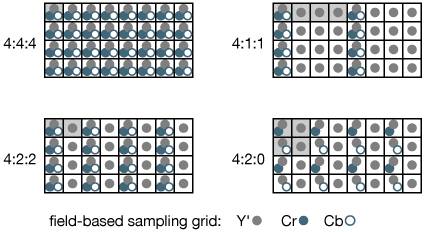基于jpeg的色度次采样算法
我正在尝试编写一个jpeg编码器,并在创建收集适当的Y、Cb和Cr颜色分量的算法时遇到挫折,以便传递给执行转换的方法。
据我所知,四种最常见的次抽样变体的设置如下(我可能在这里离这里很远):
- 4:4-一个8x8像素的MCU块,每个像素中代表Y、Cb和Cr。
- 4:2:2 -一个16×8像素的MCU块,每个像素有Y,每两个像素有Cb、Cr。
- 4:2:0 -一个16×16像素的单片机块,Y每两个像素,Cb,Cr每四个
到目前为止,我发现的关于laout的最明确的描述是这里。
我不明白的是,如何以正确的顺序收集这些组件,作为一个8x8块进行转换和量化。
有人能写一个例子吗?(我肯定,C#会更好地使用伪代码),如何将字节分组以进行转换?
我将包括正在运行的当前、不正确的代码。
/// <summary>
/// Writes the Scan header structure
/// </summary>
/// <param name="image">The image to encode from.</param>
/// <param name="writer">The writer to write to the stream.</param>
private void WriteStartOfScan(ImageBase image, EndianBinaryWriter writer)
{
// Marker
writer.Write(new[] { JpegConstants.Markers.XFF, JpegConstants.Markers.SOS });
// Length (high byte, low byte), must be 6 + 2 * (number of components in scan)
writer.Write((short)0xc); // 12
byte[] sos = {
3, // Number of components in a scan, usually 1 or 3
1, // Component Id Y
0, // DC/AC Huffman table
2, // Component Id Cb
0x11, // DC/AC Huffman table
3, // Component Id Cr
0x11, // DC/AC Huffman table
0, // Ss - Start of spectral selection.
0x3f, // Se - End of spectral selection.
0 // Ah + Ah (Successive approximation bit position high + low)
};
writer.Write(sos);
// Compress and write the pixels
// Buffers for each Y'Cb Cr component
float[] yU = new float[64];
float[] cbU = new float[64];
float[] crU = new float[64];
// The descrete cosine values for each componant.
int[] dcValues = new int[3];
// TODO: Why null?
this.huffmanTable = new HuffmanTable(null);
// TODO: Color output is incorrect after this point.
// I think I've got my looping all wrong.
// For each row
for (int y = 0; y < image.Height; y += 8)
{
// For each column
for (int x = 0; x < image.Width; x += 8)
{
// Convert the 8x8 array to YCbCr
this.RgbToYcbCr(image, yU, cbU, crU, x, y);
// For each component
this.CompressPixels(yU, 0, writer, dcValues);
this.CompressPixels(cbU, 1, writer, dcValues);
this.CompressPixels(crU, 2, writer, dcValues);
}
}
this.huffmanTable.FlushBuffer(writer);
}
/// <summary>
/// Converts the pixel block from the RGBA colorspace to YCbCr.
/// </summary>
/// <param name="image"></param>
/// <param name="yComponant">The container to house the Y' luma componant within the block.</param>
/// <param name="cbComponant">The container to house the Cb chroma componant within the block.</param>
/// <param name="crComponant">The container to house the Cr chroma componant within the block.</param>
/// <param name="x">The x-position within the image.</param>
/// <param name="y">The y-position within the image.</param>
private void RgbToYcbCr(ImageBase image, float[] yComponant, float[] cbComponant, float[] crComponant, int x, int y)
{
int height = image.Height;
int width = image.Width;
for (int a = 0; a < 8; a++)
{
// Complete with the remaining right and bottom edge pixels.
int py = y + a;
if (py >= height)
{
py = height - 1;
}
for (int b = 0; b < 8; b++)
{
int px = x + b;
if (px >= width)
{
px = width - 1;
}
YCbCr color = image[px, py];
int index = a * 8 + b;
yComponant[index] = color.Y;
cbComponant[index] = color.Cb;
crComponant[index] = color.Cr;
}
}
}
/// <summary>
/// Compress and encodes the pixels.
/// </summary>
/// <param name="componantValues">The current color component values within the image block.</param>
/// <param name="componantIndex">The componant index.</param>
/// <param name="writer">The writer.</param>
/// <param name="dcValues">The descrete cosine values for each componant</param>
private void CompressPixels(float[] componantValues, int componantIndex, EndianBinaryWriter writer, int[] dcValues)
{
// TODO: This should be an option.
byte[] horizontalFactors = JpegConstants.ChromaFourTwoZeroHorizontal;
byte[] verticalFactors = JpegConstants.ChromaFourTwoZeroVertical;
byte[] quantizationTableNumber = { 0, 1, 1 };
int[] dcTableNumber = { 0, 1, 1 };
int[] acTableNumber = { 0, 1, 1 };
for (int y = 0; y < verticalFactors[componantIndex]; y++)
{
for (int x = 0; x < horizontalFactors[componantIndex]; x++)
{
// TODO: This can probably be combined reducing the array allocation.
float[] dct = this.fdct.FastFDCT(componantValues);
int[] quantizedDct = this.fdct.QuantizeBlock(dct, quantizationTableNumber[componantIndex]);
this.huffmanTable.HuffmanBlockEncoder(writer, quantizedDct, dcValues[componantIndex], dcTableNumber[componantIndex], acTableNumber[componantIndex]);
dcValues[componantIndex] = quantizedDct[0];
}
}
}这段代码是我在Github上编写的开源库的一部分。
回答 1
Stack Overflow用户
发布于 2016-03-04 08:31:29
JPEG颜色次采样可以实现简单,但功能的方式,没有太多的代码。基本思想是你的眼睛对颜色的变化和亮度的变化不那么敏感,所以JPEG文件可以通过丢弃一些颜色信息来小得多。有许多方法可以对颜色信息进行子采样,但是JPEG图像倾向于使用4种变体:无、1/2水平、1/2垂直和1/2 horizontal+vertical。还有额外的TIFF/EXIF选项,例如亚采样颜色的“中心点”,但是为了简单起见,我们将使用和技术的平均值。
在最简单的情况下(没有次采样),每个MCU (最小编码单元)是一个由3个部件组成的8x8像素块-- Y、Cb、Cr。该图像在8x8像素块中处理,其中三个颜色分量被分离,通过DCT变换并按顺序(Y、Cb、Cr)写入文件。在所有的次采样情况下,DCT块总是由8x8系数或64个值组成,但这些值的含义由于颜色的次采样而不同。
下一个最简单的情况是在一维(水平或垂直)中进行次采样。让我们为这个例子使用1/2的水平次抽样。单片机现在16像素宽8像素高.现在每个单片机的压缩输出将是4 8x8 DCT块(Y0、Y1、Cb、Cr)。Y0表示左侧8x8像素块的luma值,Y1表示右侧8x8像素块的luma值。基于像素水平对的平均值,Cb和Cr值分别为8x8块。我在这里找不到任何好的图像,但是一些伪代码可以派上用场。
(更新:可能代表次采样的图像:)

下面是一个简单的循环,它对我们的1/2水平情况进行颜色次采样:
unsigned char ucCb[8][8], ucCr[8][8];
int x, y;
for (y=0; y<8; y++)
{
for (x=0; x<8; x++)
{
ucCb[y][x] = (srcCb[y][x*2] + srcCb[y][(x*2)+1] + 1)/2; // average each horiz pair
ucCr[y][x] = (srcCr[y][x*2] + srcCr[y][(x*2)+1] + 1)/2;
} // for x
} // for y正如你所看到的,它没有什么意义。从源图像中的每一对Cb和Cr像素水平平均以形成新的Cb/Cr像素。然后,这些是DCT变换,锯齿和编码的形式与以往一样。
最后,对于2x2子样例,单片机现在是16×16像素,所写的离散余弦变换块将是Y0、Y1、Y2、Y3、Cb、Cr。其中,Y0表示左上8x8卢马像素,Y1表示右上角,Y2表示左下角,Y3表示右下角。在这种情况下,Cb和Cr值表示4个源像素(2x2),它们被平均在一起。万一您想知道,颜色值在YCbCr颜色空间中是平均的。如果在RGB颜色空间中将像素平均起来,它将不能正常工作。
Adobe支持RGB颜色空间中的JPEG图像(而不是YCbCr)。这些图像不能使用颜色二次采样,因为R、G和B是同等重要的,在这个颜色空间中对它们进行过采样会导致更糟糕的视觉伪影。
https://stackoverflow.com/questions/35497075
复制相似问题

